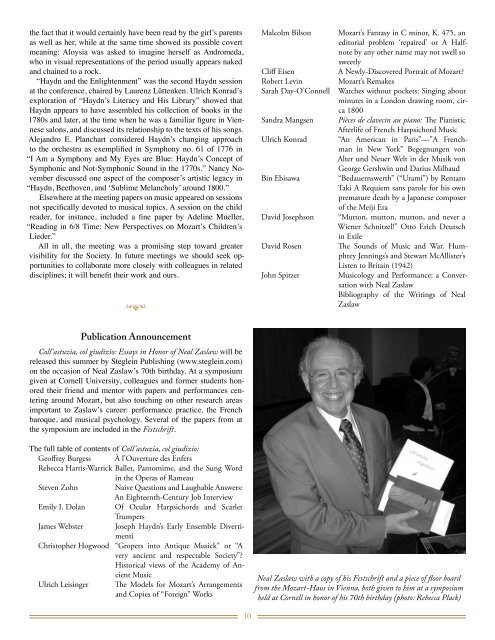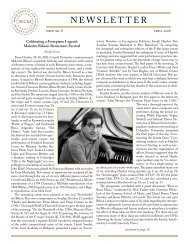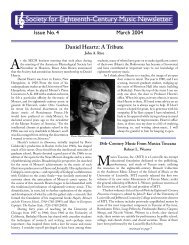NEWSLETTER - Society for 18th-Century Music
NEWSLETTER - Society for 18th-Century Music
NEWSLETTER - Society for 18th-Century Music
You also want an ePaper? Increase the reach of your titles
YUMPU automatically turns print PDFs into web optimized ePapers that Google loves.
the fact that it would certainly have been read by the girl’s parents<br />
as well as her, while at the same time showed its possible covert<br />
meaning: Aloysia was asked to imagine herself as Andromeda,<br />
who in visual representations of the period usually appears naked<br />
and chained to a rock.<br />
“Haydn and the Enlightenment” was the second Haydn session<br />
at the conference, chaired by Laurenz Lüttenken. Ulrich Konrad’s<br />
exploration of “Haydn’s Literacy and His Library” showed that<br />
Haydn appears to have assembled his collection of books in the<br />
1780s and later, at the time when he was a familiar figure in Viennese<br />
salons, and discussed its relationship to the texts of his songs.<br />
Alejandro E. Planchart considered Haydn’s changing approach<br />
to the orchestra as exemplified in Symphony no. 61 of 1776 in<br />
“I Am a Symphony and My Eyes are Blue: Haydn’s Concept of<br />
Symphonic and Not-Symphonic Sound in the 1770s.” Nancy November<br />
discussed one aspect of the composer’s artistic legacy in<br />
“Haydn, Beethoven, and ‘Sublime Melancholy’ around 1800.”<br />
Elsewhere at the meeting papers on music appeared on sessions<br />
not specifically devoted to musical topics. A session on the child<br />
reader, <strong>for</strong> instance, included a fine paper by Adeline Mueller,<br />
“Reading in 6/8 Time: New Perspectives on Mozart’s Children’s<br />
Lieder.”<br />
All in all, the meeting was a promising step toward greater<br />
visibility <strong>for</strong> the <strong>Society</strong>. In future meetings we should seek opportunities<br />
to collaborate more closely with colleagues in related<br />
disciplines; it will benefit their work and ours.<br />
D<br />
Malcolm Bilson<br />
Cliff Eisen<br />
Robert Levin<br />
Sarah Day-O’Connell<br />
Sandra Mangsen<br />
Ulrich Konrad<br />
Bin Ebisawa<br />
David Josephson<br />
David Rosen<br />
John Spitzer<br />
Mozart’s Fantasy in C minor, K. 475, an<br />
editorial problem ‘repaired’ or A Halfnote<br />
by any other name may not swell so<br />
sweetly<br />
A Newly-Discovered Portrait of Mozart<br />
Mozart’s Remakes<br />
Watches without pockets: Singing about<br />
minutes in a London drawing room, circa<br />
1800<br />
Pièces de clavecin au piano: The Pianistic<br />
Afterlife of French Harpsichord <strong>Music</strong><br />
“An American in Paris”—”A Frenchman<br />
in New York” Begegnungen von<br />
Alter und Neuer Welt in der Musik von<br />
George Gershwin und Darius Milhaud<br />
“Bedauernswerth” (“Urami”) by Rentaro<br />
Taki A Requiem sans parole <strong>for</strong> his own<br />
premature death by a Japanese composer<br />
of the Meiji Era<br />
“Mutton, mutton, mutton, and never a<br />
Wiener Schnitzel!” Otto Erich Deutsch<br />
in Exile<br />
The Sounds of <strong>Music</strong> and War. Humphrey<br />
Jennings’s and Stewart McAllister’s<br />
Listen to Britain (1942)<br />
<strong>Music</strong>ology and Per<strong>for</strong>mance: a Conversation<br />
with Neal Zaslaw<br />
Bibliography of the Writings of Neal<br />
Zaslaw<br />
Publication Announcement<br />
Coll’astuzia, col giudizio: Essays in Honor of Neal Zaslaw will be<br />
released this summer by Steglein Publishing (www.steglein.com)<br />
on the occasion of Neal Zaslaw’s 70th birthday. At a symposium<br />
given at Cornell University, colleagues and <strong>for</strong>mer students honored<br />
their friend and mentor with papers and per<strong>for</strong>mances centering<br />
around Mozart, but also touching on other research areas<br />
important to Zaslaw’s career: per<strong>for</strong>mance practice, the French<br />
baroque, and musical psychology. Several of the papers from at<br />
the symposium are included in the Festschrift.<br />
The full table of contents of Coll’astuzia, col giudizio:<br />
Geoffrey Burgess À l’Ouverture des Enfers<br />
Rebecca Harris-Warrick Ballet, Pantomime, and the Sung Word<br />
in the Operas of Rameau<br />
Steven Zohn Naive Questions and Laughable Answers:<br />
An Eighteenth-<strong>Century</strong> Job Interview<br />
Emily I. Dolan Of Ocular Harpsichords and Scarlet<br />
Trumpets<br />
James Webster Joseph Haydn’s Early Ensemble Divertimenti<br />
Christopher Hogwood “Gropers into Antique <strong>Music</strong>k“ or “A<br />
very ancient and respectable <strong>Society</strong>”<br />
Historical views of the Academy of Ancient<br />
<strong>Music</strong><br />
Ulrich Leisinger The Models <strong>for</strong> Mozart’s Arrangements<br />
and Copies of “Foreign” Works<br />
Neal Zaslaw with a copy of his Festschrift and a piece of floor board<br />
from the Mozart-Haus in Vienna, both given to him at a symposium<br />
held at Cornell in honor of his 70th birthday (photo: Rebecca Plack)<br />
10





